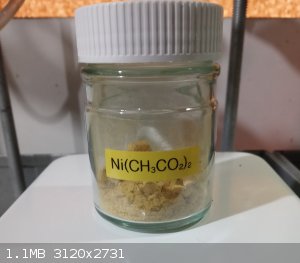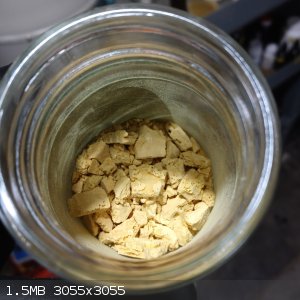Newton2.0
Hazard to Self
 
Posts: 63
Registered: 12-8-2019
Member Is Offline
|
|
Nickel Acetate from Nickel Chloride
I have made some Nickel Acetate, however, the finished product is a goldenrod yellow color while the color of the tetrahydrate is supposed to be a
teal green/blue.
According to the equation:
NiCl2 + 2CH3COOH ---> Ni(CH3CO2)2 + 2HCl
I added 25g (0.42 moles) of glacial acetic acid to 50g (0.21 moles) of NiCl2 in a 500mL beaker and heated until the mixture was solid. I
broke the solid up and placed it into a container.
I am perplexed by the color issue. What garage/hobby-level analytical techniques can I use to determine the product that I have?
 
|
|
|
DraconicAcid
International Hazard
    
Posts: 4278
Registered: 1-2-2013
Location: The tiniest college campus ever....
Member Is Offline
Mood: Semi-victorious.
|
|
If you used glacial acetic acid, the you won't have a hydrate- it may be the anhydrous nickel acetate, it may be the anhydrous nickel chloride, or it
may the a mixture of them both.
Please remember: "Filtrate" is not a verb.
Write up your lab reports the way your instructor wants them, not the way your ex-instructor wants them.
|
|
|
njl
National Hazard
   
Posts: 609
Registered: 26-11-2019
Location: under the sycamore tree
Member Is Offline
Mood: ambivalent
|
|
Dissolve a sample in water and check pH
Add lead or other suitable acetate to precipitate remaining chloride in solution
Recrystallize from methanol
Reflux condenser?? I barely know her!
|
|
|
Newton2.0
Hazard to Self
 
Posts: 63
Registered: 12-8-2019
Member Is Offline
|
|
I was kinda thinking it would be the anhydrous nickel acetate but I could find no reference images. But yeah, it is probably a mixture of the acetate
and chloride.
|
|
|
Maurice VD 37
Hazard to Self
 
Posts: 66
Registered: 31-12-2018
Member Is Offline
|
|
Are you sure that HCl has been eliminated from your mixture ? Who knows ? Maybe NiCl2 is still here unchanged ... Because NiCl2 is green when
hydrated. But anhydrous NiCl2 is yellow. Maybe acetic acid has simply replaced H2O.
|
|
|
Newton2.0
Hazard to Self
 
Posts: 63
Registered: 12-8-2019
Member Is Offline
|
|
Yeah, I am going to have to find a way to determine what this is. I'll look and see what tests I can find.
It is green when dissolved in solution and the pH does seem to be approximately neutral for a solution of about 0.5g/10mL.
Maurice, you are suggesting that the nickel chloride may have complexed with acetic acid as opposed to the normal water hydrate? That would be weird.
It is possible that I just boiled off the acetic acid and was left with the anhydrous nickel chloride. That's pretty unfortunate :(
Sucks that the visual characteristics of both the chloride and the acetate are so similar.
|
|
|
Boffis
International Hazard
    
Posts: 1836
Registered: 1-5-2011
Member Is Offline
Mood: No Mood
|
|
The preparation of nickel acetate is surprisingly difficult. It is best prepared by the vacuum assisted evaporation of a solution of nickel hydroxide
or carbonate in excess acetic acid. If an aqueous solution is evaporated without excess acetic acid a pale green insoluble basic acetate forms. The
solubility curve for nickel acetate is almost flat so cooling a solution of nickel acetate results in very little. I agree with Draconic acid that the
yellow material you have prepared is more likely anhydrous nickel chloride.
The tetrahydrate I have prepared is a pale bluish green in colour, somewhat similar to nickel ammonium sulphate, and easily soluble in cold water. It
does not change colour on contact with water so I suggest you test a bit of your material by adding a little water, if it turns green then you
probably have an anhydrous or lower hydrate salt. Add a little acetic acid and more water until it dissolves and test with dilute silver nitrate
solution; a dense white amorphous ppt suggests that much chloride is still present.
|
|
|
symboom
International Hazard
    
Posts: 1143
Registered: 11-11-2010
Location: Wrongplanet
Member Is Offline
Mood: Doing science while it is still legal since 2010
|
|
What acetic acid a weak acid replaced a chloride salt of a strong acid this does not seem like it would be possible.
Maybe test for chloride ions.
Double displacement in ethanol could be a method to maintain anhydrous conditions in a reaction
Nickel chloride (aq)
Sodium acetate (aq)
Sodium chloride insouble
Nickel acetate (aq)
Remove the precipitated salt then evaporate the ethanol off
You should end up with anhydrous nickel acetate.
Nickel acetate
It may be dehydrated in vaccum by reaction with acetic anhydride, or by heat.
|
|
|
zed
International Hazard
    
Posts: 2277
Registered: 6-9-2008
Location: Great State of Jefferson, City of Portland
Member Is Offline
Mood: Semi-repentant Sith Lord
|
|
Are you following a published procedure?
I might be wrong, but I too might have employed Sodium Acetate.
Generally speaking, you produce weaker acids, from stronger acid..... Not, visa versa.
I think it could all be run in water, but.......
I'd have a greater faith in NiCl2+Na2CO3--> NiCO3 PPT + NaCl. Filter the insoluble NiCO3 from the NaCl solution.
Then, reflux the Nickel Carbonate with Aqueous Acetic Acid, until it dissolves. CO2 should be evolved.
NiCO3+ 2CH3COOH---> CO2 + CH3COONiOOCCH3-xH2O
Reactions are DRIVEN. In this case, first by a Strongly electropositive Na ion, combining with a Strongly elecronegative Cl ion.... AND the
precipitation of the insoluble NiCO3.
Then, the weak Carbonic Acid, is displaced by the stronger Acetic Acid, and the Carbonic Acid leaves as CO2.
Maybe. I'm just guessing.
Nickel Carbonate isn't very soluble, and Acetic Acid isn't a very strong acid. It might take a while to completion...
|
|
|
njl
National Hazard
   
Posts: 609
Registered: 26-11-2019
Location: under the sycamore tree
Member Is Offline
Mood: ambivalent
|
|
Zed is right, at first I didn't want to suggest starting over with nickel carbonate (so as to not waste GAA) but that really is the best way. If you
are willing to use GAA again you should do what Zed suggested, namely dissolving your product in water, precipitating with excess aqueous sodium
carbonate, filter/wash/dry, and then reflux with GAA. You *might* even be able to get an anhydrous product if you can dry the nickel carbonate at a
low enough temperature to not expel CO2.
Reflux condenser?? I barely know her!
|
|
|
Maurice VD 37
Hazard to Self
 
Posts: 66
Registered: 31-12-2018
Member Is Offline
|
|
Are your sure that a reaction did happen in your mixture ? It the reaction did proceed as you said, you must have observed a huge production of HCL
which is a gaz. If not the yellow cake you have observed may simply be anhydrous nickel chloride which is yellow. N nickel chloride is green when
hydrated as NiCl2·2H2O. So I suspect that the one effet of adding acetic acid is to remove the 2 water molecules of the initial nickel chloride.
|
|
|